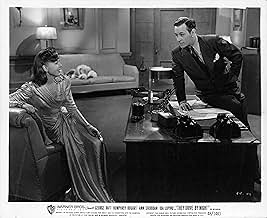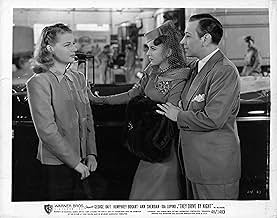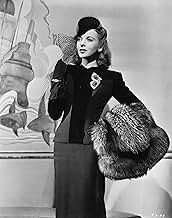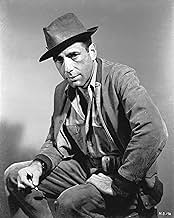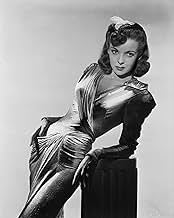IMDb RATING
7.2/10
9.7K
YOUR RATING
When one of two truck-driving brothers loses an arm, they both join a transport company where the other is falsely charged as an accessory in the murder of the owner.When one of two truck-driving brothers loses an arm, they both join a transport company where the other is falsely charged as an accessory in the murder of the owner.When one of two truck-driving brothers loses an arm, they both join a transport company where the other is falsely charged as an accessory in the murder of the owner.
- Director
- Writers
- Stars
- Awards
- 2 wins total
Eddie Acuff
- Driver in Café
- (uncredited)
William Bendix
- Truck Driver Watching Pinball Game
- (uncredited)
Marie Blake
- Waitress
- (uncredited)
Chet Brandenburg
- Man Griping at Farnsworth
- (uncredited)
Eddy Chandler
- Driver
- (uncredited)
Richard Clayton
- Young Man
- (uncredited)
Joyce Compton
- Sue Carter
- (uncredited)
Alan Davis
- Driver
- (uncredited)
Joe Devlin
- Fatso
- (uncredited)
- Director
- Writers
- All cast & crew
- Production, box office & more at IMDbPro
Featured reviews
Let's get this out of the way first: Humphrey Bogart's legions of fans seem impelled to insult George Raft as often as possible, no matter how inappropriate or clearly wrong. Those not so blinded will thoroughly enjoy this odd, mixed bag of a picture. Raft and Bogey play brothers - very believably so - who are wildcat truck drivers trying to get ahead in a tough business during the Depression. The film is odd because it seems like two separate movies. It starts out as a seeming social commentary on the hard life of truckers with fine characterizations. But as soon as Ida Lupino appears it veers straight into film noir. I, personally, would have preferred a continuation of the tone of the first part of the film rather than be subjected to the "crazy b----" act that so many call "classic" and "stealing the picture." There either should have been more foreshadowing of this switch early in the film, or the screenwriters should have found something more consistent. At any rate, Raft and Bogart get to step away from gangster roles for a breather. They're still tough guys, but they're vulnerable to the whims of fate. Raft, in fact, is adorable here, uncharacteristically blue-collar and common, desperate to be in charge of his own life. He has instant chemistry with no-nonsense Ann Sheridan. Raft works so comfortably under Walsh's direction, it's rather refreshing. If rumors are true and Bogart and Raft were not getting along at this point, they were both professionals and hid it very well. Blame Lupino, but by the second half of the film, Bogart practically disappears just when we'd like to see more development of his very sympathetic character. For Bogart fans, this is not a "Bogey" film. He's simply prepping for legend-status just around the corner. It would have been nice to see more of Sheridan, as well. I don't recall Alan Hale ever being better than he is here - watch the small things he does with such a loud character. Lupino is definitely unforgettable, and her cult following will love this. Roscoe Karns is again a fun comic foil. The editing of the picture is sometimes a bit rough, and there is a telephone sequence that does not visually work. Arthur Edeson was a frustratingly inconsistent cinematographer, ranging from brilliant work like "Casa Blanca" to B level work. This is somewhere in the middle, but the road sequences are great.
This is the kind of movie that makes movie buffs movie buffs. On the surface the story is routine (I'm tempted to say hackneyed), the psychology shallow, the acting variable, and the meaning, such as it can be said to have one, borderline moronic. Yet it works like a charm, and is a minor classic of its kind. This is a tough movie to categorize. Not that one has to. It's a long haul trucker movie. But is that a genre? It has comedy and romance but is neither a comedy nor a romance; and it has tragedy but is not a tragedy. Near the end it turns into a murder story, though I wouldn't call it a crime picture. Director Raoul Walsh had a flair for subverting genres anyway, and made basically Raoul Walsh pictures, whatever the putative genre, and this one's about as Raoul Walsh as you can get.
It's the story of two brothers, played by George Raft and Humphrey Bogart, who are wildcat truckers who don't want to work for anyone else. They'd like to own their own rig but can't afford one, and are in debt up to their ears half the time. As the story progresses, Bogart loses in arm in an accident, and the boys have to go work for the boorish if amiable Alan Hale, whose wife, Ida Lupino, has eyes for Raft. Ann Sheridan is also on hand, as the hash-slinging good girl Raft really belongs with. Nothing special here, no great drama, and certainly no surprises. What drives the film, literally, is its optimism, especially as it relates to "little guys" Raft and Bogart. Without being too emphatic about it the movie is like a cheerleader for these two from start to finish.
The dialogue is salty and well-delivered by all, even the usually tedious Raft, while the background stuff,--the diners, rented rooms and garages--is beautifully detailed and always believable. Director Walsh was made for Warner Brothers, the studio that produced the film. He had a feeling for regular people, informal surroundings, the hustle and bustle of working life. Nor was he the least bit pretentious. The studio's famous liberalism didn't seem to rub off on him. He remained a populist with an anarchic streak, and was never an ideologue, hence this movie's depiction of blue collar life rings truer than most, as we know that these little guys want to be big shots (as most little guys do), and that they mean it when they say they want to give everyone a fair shake. We know in our guts that if these two ever make it to the big time they'll be awfully nice guys to work for. It's not easy for a movie to convince a viewer of such things,--it's not easy for a movie to be convincing at all, but this one is. Thanks to Raoul Walsh, with a little help from his fine cast.
It's the story of two brothers, played by George Raft and Humphrey Bogart, who are wildcat truckers who don't want to work for anyone else. They'd like to own their own rig but can't afford one, and are in debt up to their ears half the time. As the story progresses, Bogart loses in arm in an accident, and the boys have to go work for the boorish if amiable Alan Hale, whose wife, Ida Lupino, has eyes for Raft. Ann Sheridan is also on hand, as the hash-slinging good girl Raft really belongs with. Nothing special here, no great drama, and certainly no surprises. What drives the film, literally, is its optimism, especially as it relates to "little guys" Raft and Bogart. Without being too emphatic about it the movie is like a cheerleader for these two from start to finish.
The dialogue is salty and well-delivered by all, even the usually tedious Raft, while the background stuff,--the diners, rented rooms and garages--is beautifully detailed and always believable. Director Walsh was made for Warner Brothers, the studio that produced the film. He had a feeling for regular people, informal surroundings, the hustle and bustle of working life. Nor was he the least bit pretentious. The studio's famous liberalism didn't seem to rub off on him. He remained a populist with an anarchic streak, and was never an ideologue, hence this movie's depiction of blue collar life rings truer than most, as we know that these little guys want to be big shots (as most little guys do), and that they mean it when they say they want to give everyone a fair shake. We know in our guts that if these two ever make it to the big time they'll be awfully nice guys to work for. It's not easy for a movie to convince a viewer of such things,--it's not easy for a movie to be convincing at all, but this one is. Thanks to Raoul Walsh, with a little help from his fine cast.
If you could distil the essence of the actors in this quite ordinary film and add to it the forfeit George Raft paid for his poor future choices, the oyster and the world would be yours.
Truck-driving brothers GEORGE RAFT and HUMPHREY BOGART not only have to put up with the hazards of wildcat driving but the manipulations of the scheming wife of boss ALAN HALE, played with intense conviction by IDA LUPINO.
But it's a plodding tale that takes awhile to work up any steam while director Raoul Walsh concentrates on the rough-housing camaraderie of the blue collar set before getting to the heart of the story involving two very different women--the good one, ANN SHERIDAN, and the femme fatale played with relish by IDA LUPINO. It is the romantic trio that ends in tragedy that gives the film its potent interest.
Lupino's mad scene on the stand is worth waiting for--although not entirely convincing. Nevertheless, she creates a vixen you won't soon forget.
George Raft ambles pleasantly through a rather dull role while Humphrey Bogart, as his brother, attracts more attention in a sideline role. Ann Sheridan is a sheer delight, adding her usual warmth and zest to a typical Sheridan role. The script crackles with tart remarks.
Not exactly great filmmaking--and too long in getting started--but worth the wait for some good performances. Only drawback seemed to be ALAN HALE as an oafish boss who becomes even more obnoxious when he's drunk. Hale overplays the role to such a degree that, in a way, it comes as a relief to see Ida knock him off with those car doors. "The doors made me do it!" is her scream from the witness stand.
Summing up: the kind of melodrama Warner was famous for in the '40s with the right cast doing it justice.
But it's a plodding tale that takes awhile to work up any steam while director Raoul Walsh concentrates on the rough-housing camaraderie of the blue collar set before getting to the heart of the story involving two very different women--the good one, ANN SHERIDAN, and the femme fatale played with relish by IDA LUPINO. It is the romantic trio that ends in tragedy that gives the film its potent interest.
Lupino's mad scene on the stand is worth waiting for--although not entirely convincing. Nevertheless, she creates a vixen you won't soon forget.
George Raft ambles pleasantly through a rather dull role while Humphrey Bogart, as his brother, attracts more attention in a sideline role. Ann Sheridan is a sheer delight, adding her usual warmth and zest to a typical Sheridan role. The script crackles with tart remarks.
Not exactly great filmmaking--and too long in getting started--but worth the wait for some good performances. Only drawback seemed to be ALAN HALE as an oafish boss who becomes even more obnoxious when he's drunk. Hale overplays the role to such a degree that, in a way, it comes as a relief to see Ida knock him off with those car doors. "The doors made me do it!" is her scream from the witness stand.
Summing up: the kind of melodrama Warner was famous for in the '40s with the right cast doing it justice.
The film noir 'genre' has delivered a lot of great films, but few top this one; and that's really saying something considering just how many great noirs there are. The film is something of an odd one with regards to the way the plot moves; it's really a movie of three sections, and the way it jumps from the first section to the second section is wholly unexpected. I suppose the way that the film moves may be the reason why this isn't universally accepted as one of the best films of its type; but if you ask me the strange plot is one of the film's strongest points - nobody wants to sit through a predictable movie, and They Drive by Night is anything but predictable. The plot focuses on two brothers - Joe and Paul Fabrini. The pair drive a truck delivering things to the market and not making a lot of money. They finally get a break when Joe takes a risk and decides to buy his own consignment; but their luck takes a turn for the worse when Paul crashes the truck and becomes unable to work. Joe then takes a job working for his old friend Ed's company, which brings about problems of its own...
One of the trademarks of the noir style of film-making is a thick foreboding atmosphere; this film features that and then some. They Drive by Night takes it further than most, and the film almost has an affinity with the horror genre for its dark atmosphere, plot and characters. Once the film moves into the second stage, the horror elements are rampant. The acting in the film is excellent; George Raft and Humphrey Bogart are entirely convincing as the rag-tag pair of brothers, while excellent support is given from two ladies; Ann Sheridan and Ida Lupino. It's Ida Lupino that really makes this film what it is for me; her icy cold persona is breathtaking, and she holds the screen excellently. The murder scene in this film is extremely effective also; and while not as spectacular as some of the death scenes in the gory horror flicks that I often watch, its subtleness makes it memorable. The final third of the film is a courtroom drama and it's the worst part of it for me, but that isn't enough to ruin what is a brilliant film and I certainly would not hesitate to recommend They Drive by Night to noir fans and everyone else.
One of the trademarks of the noir style of film-making is a thick foreboding atmosphere; this film features that and then some. They Drive by Night takes it further than most, and the film almost has an affinity with the horror genre for its dark atmosphere, plot and characters. Once the film moves into the second stage, the horror elements are rampant. The acting in the film is excellent; George Raft and Humphrey Bogart are entirely convincing as the rag-tag pair of brothers, while excellent support is given from two ladies; Ann Sheridan and Ida Lupino. It's Ida Lupino that really makes this film what it is for me; her icy cold persona is breathtaking, and she holds the screen excellently. The murder scene in this film is extremely effective also; and while not as spectacular as some of the death scenes in the gory horror flicks that I often watch, its subtleness makes it memorable. The final third of the film is a courtroom drama and it's the worst part of it for me, but that isn't enough to ruin what is a brilliant film and I certainly would not hesitate to recommend They Drive by Night to noir fans and everyone else.
Did you know
- TriviaThe wife of producer Mark Hellinger, Gladys Glad, a former showgirl for Broadway producer Florenz Ziegfeld Jr., was responsible for getting this film made. Hellinger had brought home a large stack of scripts that he was to read for filming consideration. He had leafed through the script and read the summary, but felt that "nobody would pay money to see a bunch of truck drivers." His wife read this script, liked it, and pressured Hellinger to read it. Reluctantly, he did, the film eventually got made, and it became the sleeper hit of the year for Warners. It was made for an estimated $400,000 and grossed more than $4 million. (Source: Book "The Mark Hellinger Story" by Jim Bishop, New York: Appleton-Century-Crofts, 1952)
- GoofsWhen Joe and Paul's truck crashes, a motorist in a 1933 Cadillac with California license number 2N 214 stops to give assistance. Later, at Ed and Lana Carlson's anniversary party the same car (and same license number) is shown as one of Ed's cars as he demonstrates his garage door opener.
- Quotes
Ed Carlsen: Early to rise and early to bed, makes a man healthy, but socially dead!
- ConnectionsFeatured in Hollywood: The Great Stars (1963)
- SoundtracksWhen the Swallows Come Back to Capistrano
(1940) (uncredited)
Music by Leon René
Played at Mandel's Cafe
- How long is They Drive by Night?Powered by Alexa
Details
- Release date
- Country of origin
- Official site
- Languages
- Also known as
- They Drive by Night
- Filming locations
- Production company
- See more company credits at IMDbPro
Box office
- Budget
- $400,000 (estimated)
- Runtime1 hour 35 minutes
- Color
- Aspect ratio
- 1.33 : 1
Contribute to this page
Suggest an edit or add missing content



